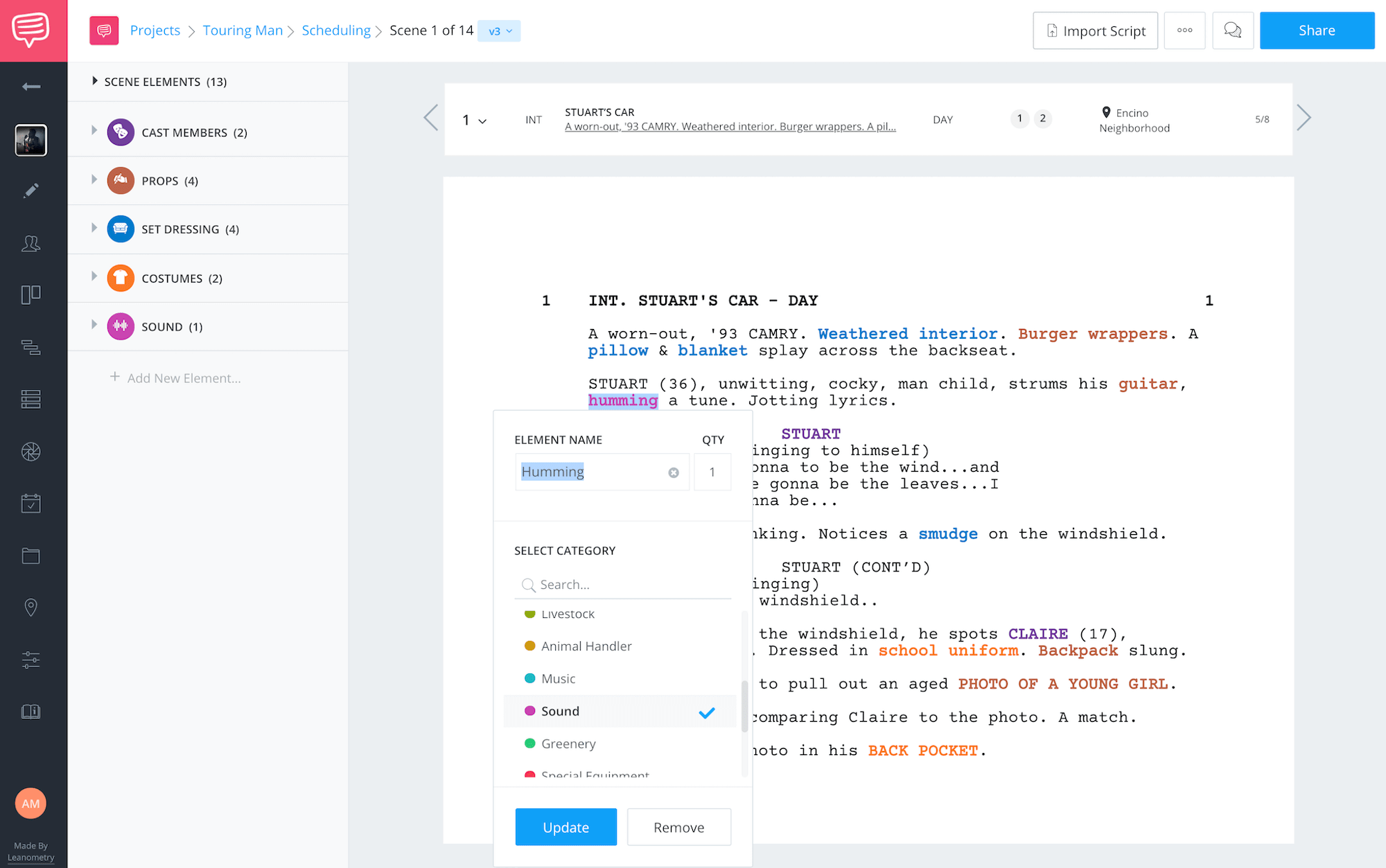When we think of micro-budget filmmaking, we think of the film’s budget, distribution, or possibly marketing, as the most crucial element. The process, after all is one that mystifies and entraps legions of filmmakers. Furthermore, how to navigate the often-frustrating world of ultra low-budget filmmaking is something that escapes even those filmmakers in the midst of it.
But, with over 20 years experience in the film industry, filmmaker Alex Ferrari knows the most essential aspect of the micro-budget filmmaking process is freedom. He has figured out that a lack of freedom can stifle a filmmaker’s project. Recently, we had the opportunity to speak with Alex about creating successful, micro-budget films.
1.1 INDIE HUSTLER
Meet Alex Ferrari
Alex Ferrari founded Indie Film Hustle, an online blog and podcast that educates filmmakers and teaches filmmakers how to hack indie filmmaking with what they don't teach in film school. Alex investigates a range of topics, but especially micro-budget films and filmmaking.
Alex believes micro-budget features have their limitations, but that these constraints force a filmmaker to be more creative. Here are some of the most important elements we learned from out conversation with Alex.
1.2 LOW BUDGET VS MICRO BUDGET
Note the distinction between the two
So what is the micro-budget film definition?
MICRO-BUDGET FILM DEFINITION
What is a micro-budget film?
A micro-budget feature film is any feature-length film that is produced for significantly less than the average cost of the average film. Independent filmmakers would define a micro budget as any film budget less than $25,000 dollars, with minimal cast, crew, equipment or fringes that usually accompany film production.
Some examples of features considered microbudget?
- El Mariachi Directed by Robert Rodriguez - Budget $7,000
- Paranormal Activity Directed By Budget: $11,000
- Tangerine Directed by Sean Baker - Budget $100,000
In the indie world, a lot of terms get thrown around when discussing projects: low budget films, micro-budget films, no budget films.
The issue of what differentiates low budget filmmaking from micro-budget filmmaking is a question Alex hears often.
But for him, a veteran filmmaker, it all depends on perspective.
Alex explains that a filmmaker like David Fincher would look at a $100,000 movie and file that under micro-budget films.
In general though, Alex believes for a project to be a micro movie it needs to fall below $25,000.
Low budget movies on the other hand would typically exist above $30,000.
Again, these are relative numbers, but a range Alex believes to be fairly accurate. Though, the Screen Actors Guild defines Ultra-Low Budget as films under $250,000. This is the lowest tier of the SAG-Theatrical Agreement.
The Low Budget Film threshold for SAG is $2.5 Million.
1.3 THE BENEFITS OF MICRO BUDGET FILMS
Embrace the lack of funds
Freedom, as stated before, is a top priority for Alex. It is something he believes to be a major benefit of micro-budget films.
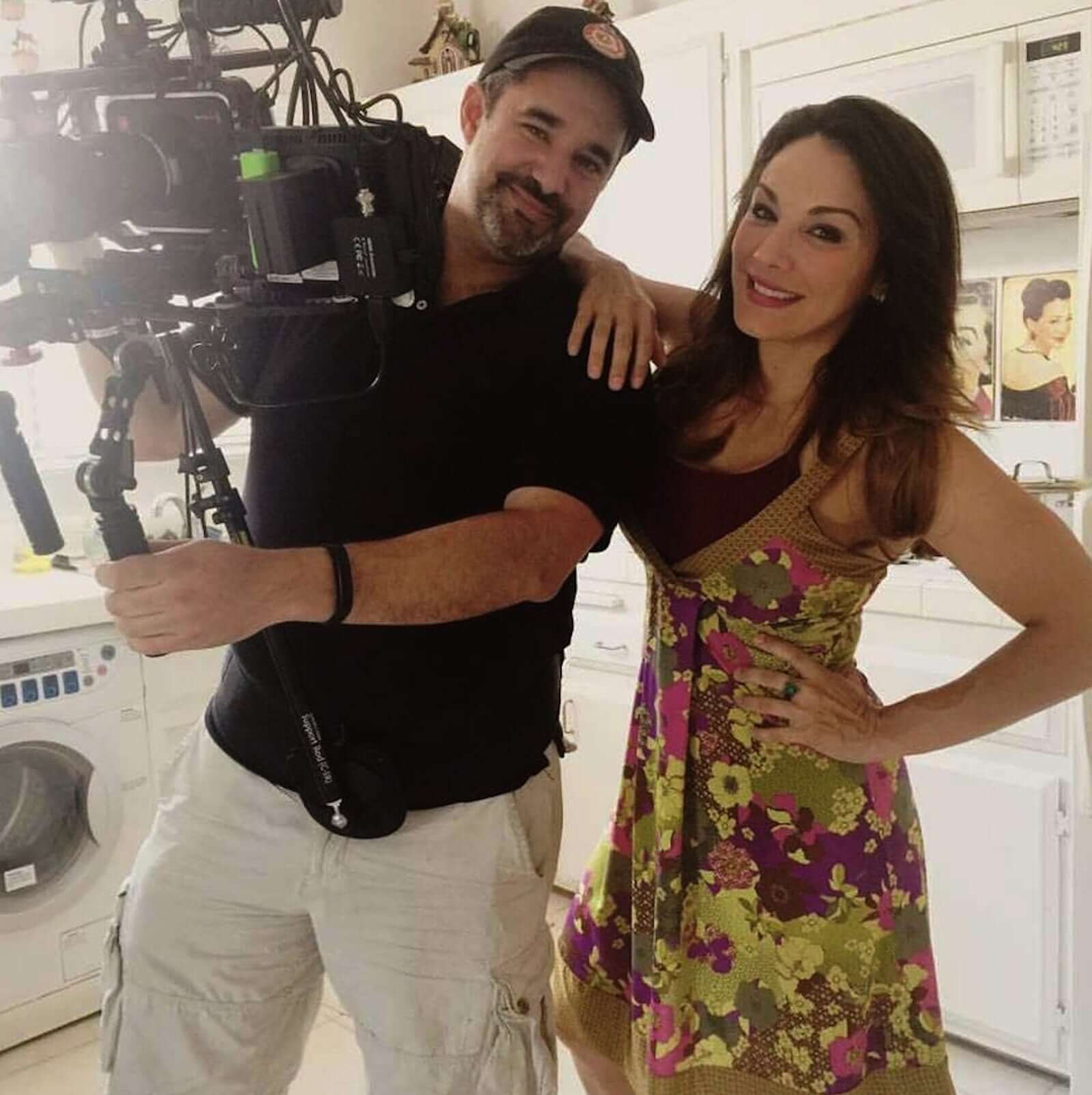
Alex Ferrari on the set of his micro-budget film This Is Meg (2017)
Alex says that shooting low budget movies are often great opportunities for filmmakers. In Alex’s experience, stress-levels decrease when creating a micro movie under $10,000 because in general it’s not the end of the world if you don’t make your money back.
Film budget constraints like these allow a director to experiment and be more spontaneous with the performances.
You don’t have to cast a big name to recoup your money.
Regarding indie filmmaking, Alex feels directors often waste time waiting around for the perfect deal or film budget.
Giving the example of Sean Baker, Alex says that before the director gained notice with Tangerine (2015), he made a string of micro-budget films.
Because Baker continued to create despite film budget constraints, he was able to surpass many of his contemporaries.
For Alex, the true beauty of the micro movie is the ability to just grab a camera, gather some actors and go out and make the project.
1.4 THE LIMITS OF MICRO BUDGET FILMS
Know what you’re getting into
By definition, micro-budget films are all about limitations. The kind of locations, equipment and casting opportunities afforded to you is limited.
But for Alex, there is power in the limitations of these low budget movies.
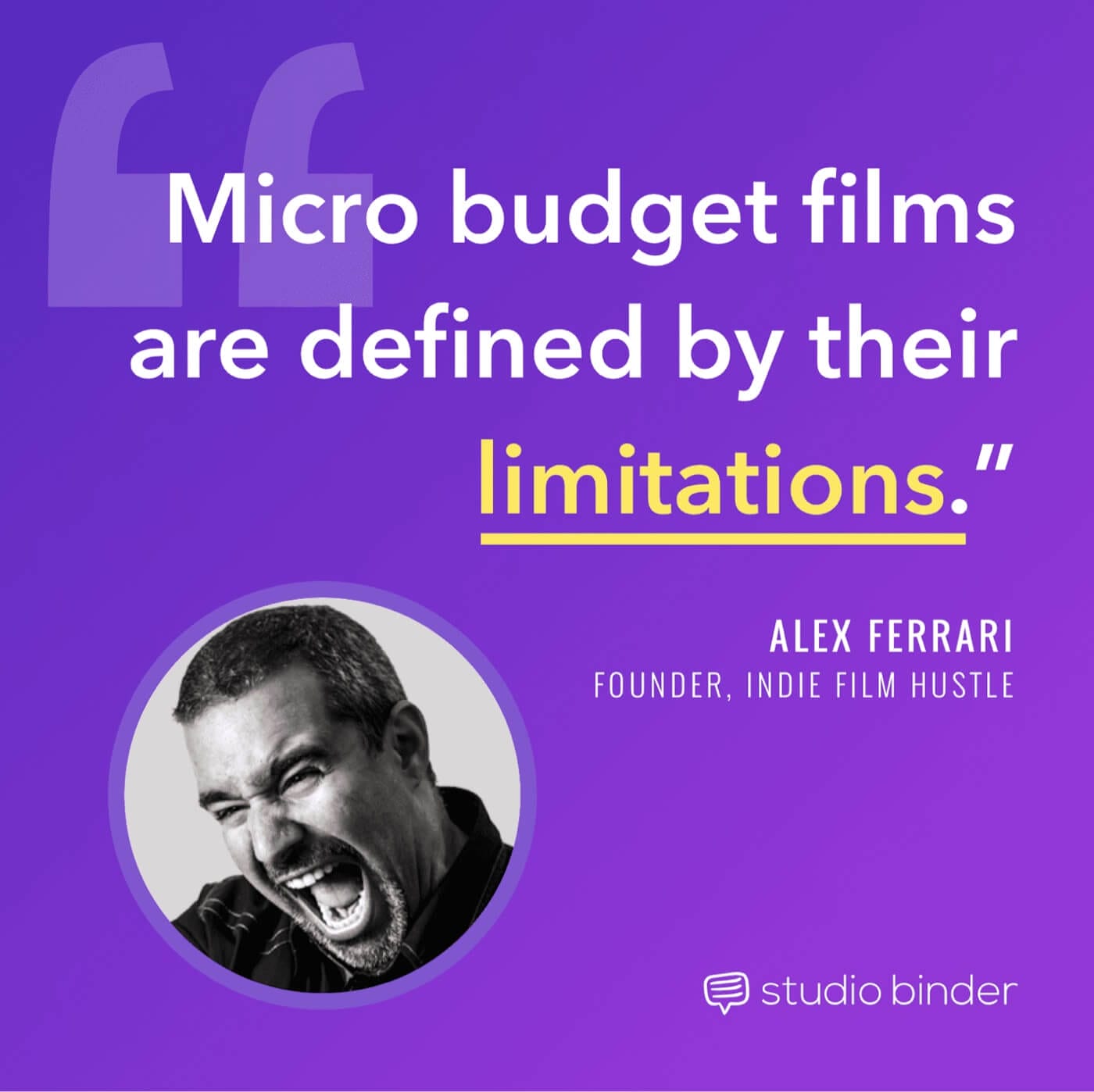
On a bigger budget film, producers would simply throw money at a problem and that would be that.
Unfortunately that luxury is unavailable for micro-budget films.
Alex believes that on a micro movie one needs to flow with the limitations.
From these creative work-arounds the true artistry of the project surfaces.
For Alex, indie filmmaking runs into trouble when the ambitions of the director become too grandiose.
As Alex says, you’re not going to make Lord of the Rings on a $10,000 budget.
It might be useful to get a firm grasp on budget essentials. If you could benefit, check out this essential guide for crafting budgets.
With micro-budget films, a filmmaker needs to be cognizant of their resources, and use those elements to craft the story.
In Alex’s opinion, stripping low budget movies down to their essentials creates a cleaner, less complicated narrative.
2.1 ESSENTIAL WORDS
The story is as important as the words
According to Alex, the production process for micro-budget films varies depending on the story.
In Alex’s experience though, a typical first step is creating a scriptment.
A scriptment combines elements of a screenplay and a treatment.
SCRIPTMENT DEFINITION
What is a scriptment?
A scriptment is a written work that brings together two elements of screenwriting, the script and the treatment. The scriptment focuses heavily on dialogue, in the same format as a long form screenplay, but usually dispels scene headings or slug lines. The creation and use of the portmanteau is credited to filmmaker James Cameron after his “script-treatment” for Avatar (2009) was leaked online.Often in the indie filmmaking world, the document does away with a majority of the dialogue, and removes the exterior and interior sluglines to read like a short story. From there, actors are able to improv most of their lines, and within the rough story beats, choose their own path to reach certain narrative milestones.
For Alex, this is where the fun lies.
The process becomes very freeing for both actors and filmmakers, knowing they have the opportunity to experiment more.
Although Alex readily admits that this approach can make things difficult in the editing room, there’s still a special kind of magic in not quite knowing how things will turn out.
In low budget movies, Alex believes this freedom is the catalyst from which the best creativity can sprout
2.2 ESSENTIAL CREW
Crucial positions for micro-budget films
Alex wants filmmakers to understand that you can’t approach micro and low budget movies like you would a big-budget, Hollywood film.
Unfortunately in low budget films, you just don’t have the resources.
But despite these film budget constraints, Alex feels there are some essential positions one cannot skimp on when it comes to a micro-budget filmmaking.
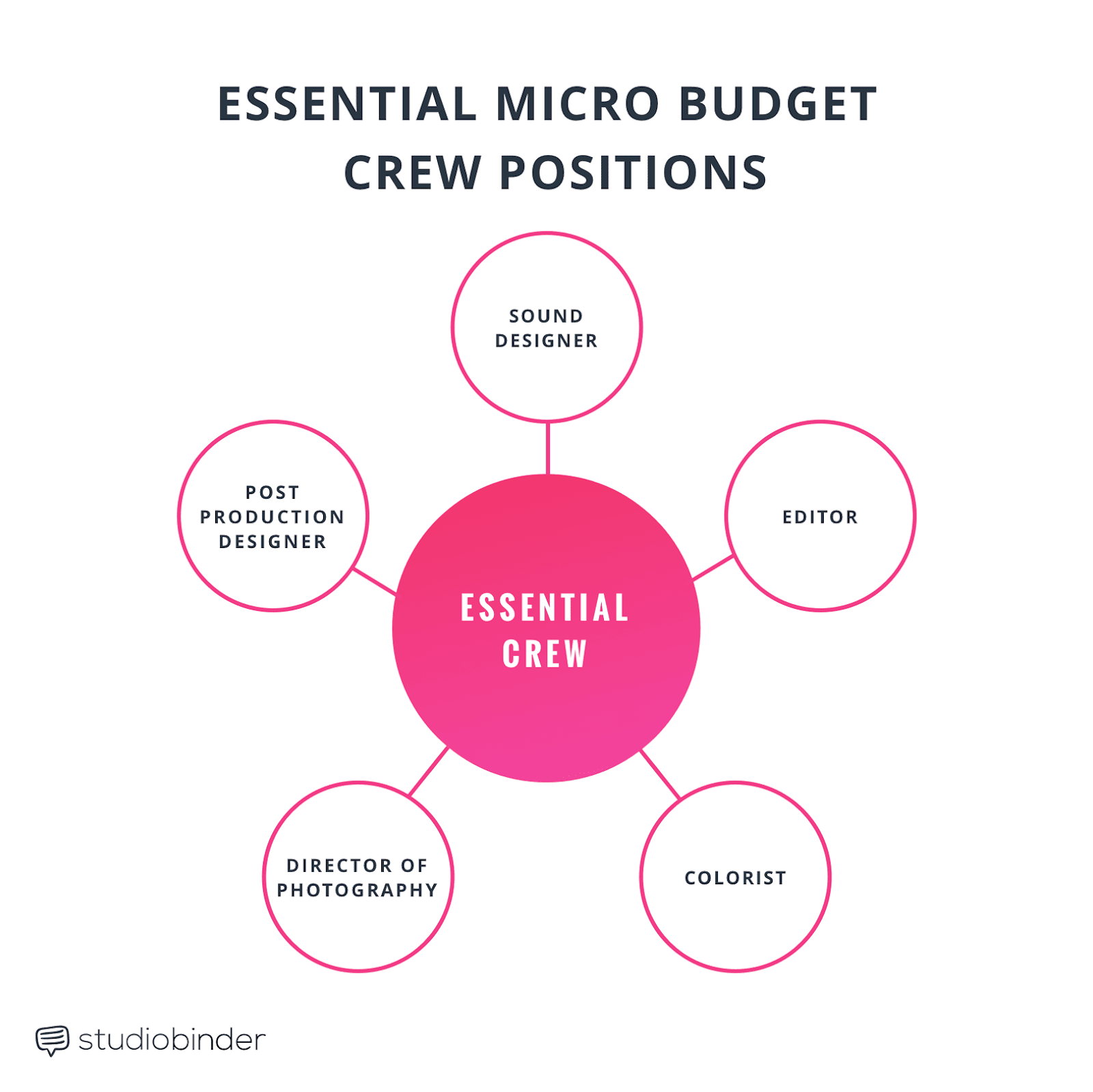
Crew roles
Cinematographer
For Alex, an experienced cinematographer is vital.
Alex says to make sure whoever is shooting the movie understands the intricacies of lighting and exposure.
Don’t just hire someone who claims to be a Director of Photography without viewing their portfolio first.
Sound Designer
Like picture, a proper sound person is integral to the production. An audience may sit through a grainy picture, but they won’t sit through something they can’t hear. Make sure your sound person can handle sound design, sound mixing, ADR and music composition if necessary.
Alex cautions the filmmaker not to take on sound themselves unless you are an audio engineer or have experience in sound design.
This is a case where you don’t have to be in the room with the sound designer. You can collaborate with them remotely.
Using a production management software like StudioBinder, you can stay on top of people and projects in real time. If you need a sound element just tag it in the script breakdown feature:
Editor and Colorist
In post-production, if you can’t do the editing yourself you need to hire a seasoned editor, and also a colorist.

Before and after color correction
More than most positions, Alex feels the colorist in micro-budget projects is often neglected to the film’s detriment.
For Alex, especially in the indie filmmaking world, a lot of directors don’t think about color, but color, is what sells the movie.
At the end of the day, if you have a polished-look to your film, it’s going to raise the production value.
Post-Production Supervisor
Even if you can’t afford one, Alex thinks it’s advantageous to at least speak with a post-production supervisor.
Proper workflow is essential for micro-budget films, and especially in post, you literally can’t afford to make mistakes.
A post-production supervisor can walk you through the entire low budget filmmaking process so you don’t make any technical mistakes.

Post Production is an essential part of the production workflow
Alex recommends paying them $150-200 for an hour of their time, so you don’t get caught in a troublesome situation down the line.
For Alex, this is an essential element to seek out.
Production Assistant
If there’s money in the budget, having what Alex calls “A Swiss Army Knife Person” can also be helpful.
This individual can act as PA, Grip, AC, or craft services. Basically a jack of all trades making sure the production continues to run smoothly.
Music Composer
Now if you’ve got a little bit of money, Alex recommends seeking out a composer as well.
In Alex’s experience, a lot of composers are willing to work for an affordable price just for the opportunity to collaborate on a feature film.
For Alex, AD’s and Producers are luxuries on micro and low budget films.
The same goes for a line producer. In Alex’s opinion, finding a line producer who’s going to help produce a $2,500 movie is probably going to be difficult.The essential duties of a line producer
Ultimately for Alex, if you can’t do the position yourself, you need to find talented people who are willing to take the micro-budget ride with you.
Related Posts
2.3. ESSENTIAL NUMBERS
Budgeting micro-budget filmmaking
In terms of budgeting micro-budget films, Alex feels the members involved in the various departments determine the cost.
The filmmaker needs to allocate ahead of time the minimum amount of money required for the actors and the crew.
This includes covering their travel and gas expenses, as well as determining a food budget.
For Alex, a well-fed crew is a happy crew.
Alex has seen too many filmmakers rely on what he calls the “Pizza-Wheel of Death,” where crews become sluggish from an overdose of high-carb foods.
Alex believes that since your team is already working for lower amounts than they normally would, you need to invest in providing them good meal options. So make sure you know what to have on your craft services table.
You also have to make sure you have all the post-production costs in order, making sure to take care of the editor, colorist and post-sound designer.
Items Micro Budget Films Cannot Skimp On
In Alex’s experience, the two things micro-budget films cannot cut corners on are sound and camera.
Alex says that too-often in low budget filmmaking, a director will pursue a person who claims to be a DP because they appeared in a posting or owns an Alexa camera.
Please don’t fall for this trap, Alex says.
Make sure the person you are hiring is capable and has experience working at the highest level of filmmaking.
Budget Percentage
As far as what percentage of budget is allocated to each department, Alex says it’s dependent on the production.
Although there’s no magical allocation, on typical micro-budget films the budget usually falls to 70 percent on production and 30 percent on post-production.
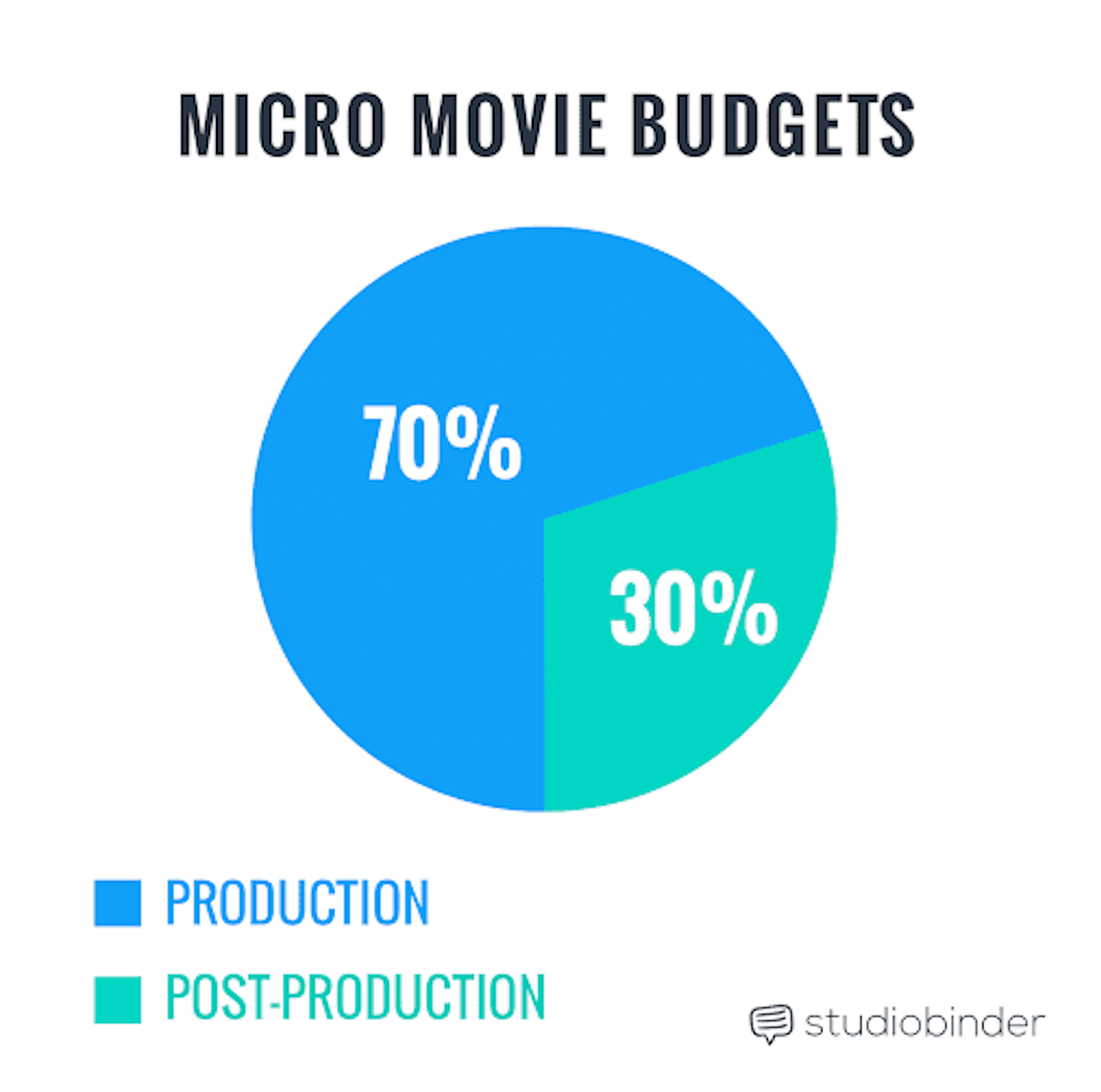
Budget basics
Alex believes that the reason for this difference is that editing has become so cheap, and most filmmakers can obtain and use editing software themselves.
If the budget ends up being closer to 50/50 then the project probably had a heavy visual effects component.
Again, these are just relative numbers, but percentages Alex feels are accurate.
Is a Budget Ever Too Low?
Another question Alex is often asked is whether there is an amount that is too low to go into production with?
Again for Alex it depends on what kind of story you’re trying to tell.
If it’s an intimate movie about two people running around several locations then you don’t need a lot of money. You just need a camera and you’re off to the races.
However, if you’re trying to do a bigger, ambitious project then you may have to wait till you have an appropriate budget.
Alex says the more ambitious a project then the more money you’ll need.
3.1 MARKETING
Getting the word out
For Alex, building an audience is key in micro-budget filmmaking.
In his view, without an audience, you won’t be able to survive as a micro-budget filmmaker. Although Alex believes wholeheartedly that a film should be an artistic expression, he also doesn’t shy away from thinking of it as a product.
This mentality is necessary in being able to successfully market your project.

Don't be afraid to think of your film as a product.
— Alex Ferrari
Crowdfunding
One way to both raise money and gain attention for your project is crowdfunding. But Alex is quick to make the distinction between crowdfunding and crowdsourcing.
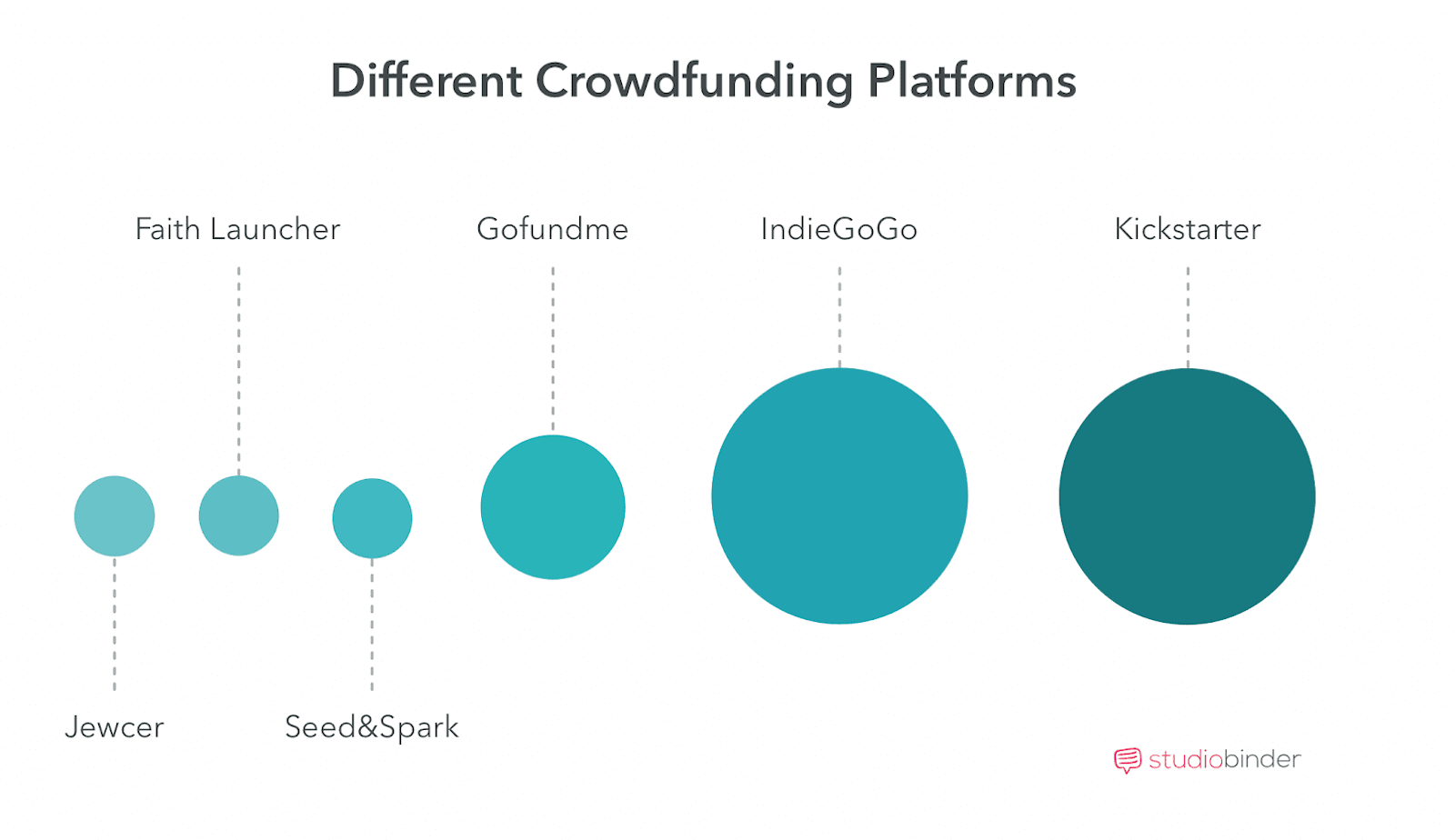
Crowdfunding platforms for your micro-budget feature
Crowdfunding is the sourcing of funds from a crowd, whereas crowdsourcing is the sourcing of services, information or ideas.
Besides raising money for a project, Alex feels crowdfunding is a great way of building awareness around your micro-budget project.
Blogging
In the digital age, Alex also recommends blogging as a promotional tool. Alex knows filmmakers who have blogged during their pre-production and production phases, garnering huge audiences by the time the film was distributed. For Alex, it’s all about finding creative ways to whet the appetite of the potential viewer.
3.2 DISTRIBUTION
Getting the film out
The big question is, what is the ultimate goal of micro-budget films?
We asked Alex what should be the endgame for a micro-budget project.

Alex says don’t get into micro movies for the money
Film distribution? A calling card towards a bigger project opportunity?
Alex says that traditionally you can self-distribute a micro-budget project fairly easily through outlets such as Distribber or Amazon Video Direct.
However, to make money back on a $2,500 budget, you need to get at least six to seven hundred people to buy it, and that’s a lot in today’s world.
This makes film distribution of a micro movie a bit tricky.
For Alex, if you’re getting into micro-budget filmmaking to earn a lot of money then you’re in the wrong business.
As with many endeavors, successful indie filmmaking is a business typically not made in a year. It’s made in decades.
Alex says call him crazy, but he’s the kind of person who likes making movies for the sake of making movies.
In terms of using a micro-budget project as a calling card for a bigger opportunity, Alex thinks that should be a plan B.
Alex believes that in the past it was a big deal to have a feature film under your belt. But due to the convenience of technology, a lot of people now have the ability to produce a feature film.For Alex, the concentration should be on quantity as well as quality.
Try to complete as many films as you can at a good production rate will prove to be beneficial in the long run.
Film Distribution Outlets For Micro Budget Projects
Something that we and a lot of people are curious about are the film distribution options for micro-budget films.
Alex says they certainly exist, but sometimes can be difficult to navigate.
For example, Amazon is open to everybody, so anybody with a feature film or series can upload the project to Amazon Video Direct.
Alex says pop it in and you’re featured in the world’s largest online marketplace.
However, Alex reminds us that unless you're able to drive traffic and attention to your project, then you’re not going to make any money off it.
Although the doors of film distribution are certainly open to micro-budget films, Alex says certain platforms are more complicated than others.
Take Netflix and Hulu for example.
Alex explains that in terms of film distribution, these platforms are looking for certain kinds of movies.
For Netflix, you need to have a name director or an audience to be considered. Alex says that Netflix is in the business of buying audiences.
If you approach these platforms with no stars and no social media following, then it makes it difficult to gain a film distribution deal.
Alex believes that Sundance or a major festival might help, but they are going to be much more stringent.
And don’t forget, Alex says, you can always pitch your micro-budget project to traditional distributors.
But understand, if you pitch to distributors like The Orchard and A24, your chances of making money back off a $5,000 micro movie is very small.
Because they're probably only going to be able to pull in $30,000 in total gross. If you’re lucky.
In terms of genre, dramas are very difficult. Comedies are easier, but what sells overseas is action, sci-fi and thrillers. Alex explains the content travels easier.
So if you want a better chance at film distribution, Alex advises to stay within one of these genres.
4
The Micro Budget World
Just Do It
4.1 ADVICE FOR FIRST-TIMERS
Heed these words of wisdom
Many of you are probably wondering what kind of advice would you have for first-time micro-budget filmmakers?
What are the guidelines for how to make a low budget movie?
Alex says the first piece of advice is to just go out and do it.
Secondly, don’t stress yourself out with high-expectations for the project or your career because of it.
In Alex’s view, it’s not fair to the micro movie or to you as an artist.
Do it for the sake of the film, and to the best of your ability.
4.2 FUNDRAISING
Raising money for micro budget movies
Something we, and many people for that matter, have been wondering is what’s the best way of raising money for micro-budget films?
In Alex’s opinion, it’s best to stay away from investors.
With investors, filmmakers needs a firm business plan, sometimes guarantors, and other special considerations. Also, with investors you’re expected to pay the money back, and it becomes difficult when you’re working on a project whose budget is $25,000 or below.
Whereas by using your own money, you own 100% of the project.
If you have to save for six months or even a couple of years then Alex thinks it’s worth it in order to completely control the film.
And of course you can always approach friends and family, but like investors, you have a responsibility to pay the money back. Unless it was a gift of course.
If you do go with the outside investor route, you definitely want to be sure to have an all-in-one production management software.
Just because it is a micro-budget feature, doesn’t mean you won’t need to keep track and organize every aspect of the production.
4.3 TRACK RECORD
The most successful micro budget films
Okay, you’re ready to dive into your micro-budget project, but are wondering what type of story has the best chance for success?
For Alex, intimate character pieces tend to be most successful.
Comedies or comedy dramas. Alex gives the examples of Clerks (1994) and The Puffy Chair (2005) as the kind of stories that tend to connect with an audience.
These films include a small amount of characters and have a lot of dialog.
On the flip side, very little dialog can be effective such as For Lovers Only (2011) which is reminiscent of French New Wave films like Breathless (1960).
If you want to craft a story outdoors, Alex recommends making it more Hitchcockian and action-based.
Forego the dialog and let the action speak for itself.
4.4 PARTNERS IN ARMS
Inspire your micro budget crew
Another thing we were curious about is how do you get cast and crew excited for a project that is operating on such a low-budget?
In micro-budget films, Alex says you have to provide people opportunities they otherwise wouldn’t get elsewhere.
Alex uses the example of a TV actor.
You have a TV actor who has been doing a comedy series for the past 10 years and suddenly you approach them and say hey, how would you like to do a drama?
It’s something you’ve never done before, but something I think you would be great in.
The actor could very well get excited and go above and beyond what is expected because of the unique opportunity.
The same goes for crew.
Let’s say you have a DP who is very seasoned from working on commercials and music videos, but they’ve never done a feature.
By offering them this opportunity, you’re suddenly piquing their interest with a project that is unfamiliar.
Alex says it’s also about building up a general aura around the film, and letting the crew know yes, you’re not getting paid a lot, but here you have the freedom to experiment.
For Alex, it’s about providing the individual value and an opportunity they wouldn’t normally get.
4.5 THE FINAL FRAME
The last thing you need to know
For Alex, the best piece of advice for aspiring micro-budget filmmakers is to just go out and do it.
Alex says shoot a lot of micro-budget films even if they’re with local actors, non-union actors or no name actors for that matter.
At least you’re proving that you can go through the process.
Yes, micro budget filmmaking does have its constraints.
But as Alex has shown, the freedom afforded by these constraints can offer the kind of compelling storytelling you wouldn’t otherwise attain.
Still curious?
Discover ways to develop short film ideas you can actually produce.
RELATED POSTS
UP NEXT
The Best Crowdfunding Sites
If the idea of a micro-budget feature hasn’t put fear into your filmmaking bones then you’re ready for the next step. Exploring crowdfunding as a way to find even a micro-budget is the way to go. Discover the best websites and strategies for your next campaign.
Project management for video creatives. Tasks, file sharing, calendars and more.
Manage video production timelines, tasks, storyboards, shot lists, breakdowns, call sheets. Made for video creatives, new media and film.

